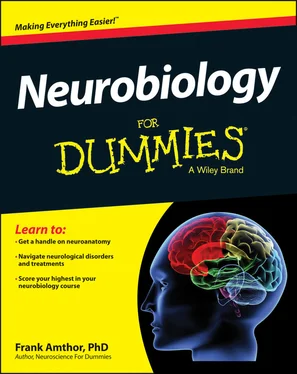 One important chemical distinction among the amino acids that make up proteins is whether the parts of the amino acid jutting out from the polypeptide chain (residues) are charged (hydrophilic or lipophobic), or relatively neutral (hydrophobic or lipophilic). The two ends of membrane proteins not embedded in the phospholipid bilayer are typically dominated by hydrophilic residues, while the portions of the protein embedded in the phospholipid bilayer are typically dominated by lipophilic residues.
One important chemical distinction among the amino acids that make up proteins is whether the parts of the amino acid jutting out from the polypeptide chain (residues) are charged (hydrophilic or lipophobic), or relatively neutral (hydrophobic or lipophilic). The two ends of membrane proteins not embedded in the phospholipid bilayer are typically dominated by hydrophilic residues, while the portions of the protein embedded in the phospholipid bilayer are typically dominated by lipophilic residues.
Peeking at the Parts of a Cell
Neurons are cells. Like all eukaryotic cells they have a nucleus with chromosomes made of DNA, surrounded by a nuclear membrane. Outside this nuclear membrane is the cytoplasm, which is surrounded by the cell membrane. The following sections discuss the parts of the neuronal cell that are common with other eukaryotic cells, and later sections discuss the differences.
Within the neuronal cytoplasm are typical eukaryotic organelles (or, plainly, parts of the cell). The following organelles reside in the cytoplasm :
Mitochondria: These are self-replicating organelles that generate adenosine triphosphate (ATP), the cell’s main energy source. ATP is generated by a process called oxidative phosphorylation, in which energy from electron transfer involving oxygen adds a phosphate to adenosine diphosphate (ADP). Mitochondria have their own DNA and multiply by cell division on their own, as needed for the cell’s energy requirements. Neurons have very high concentrations of mitochondria compared to other cells.
Endoplasmic reticulum (ER): The ER is an organelle composed of flattened tubes (cisternae) involved in protein synthesis, and carbohydrate and lipid metabolism, among other functions. ER has two forms: rough and smooth. Rough ER contains ribosomes where mRNA is used to synthesize proteins from amino acids. Smooth ER synthesizes steroids, phospholipids, and other lipids. One of its functions in neurons is the modification of cell membrane proteins that will become receptors. It also regulates (sequesters) calcium ion concentration.
Golgi apparatus: This organelle processes proteins and lipids that are synthesized by the cell. This is also where peptide neurotransmitters may be packaged into vesicles that are suitable to release outside the cell.
Lysosomes and peroxisomes: These two organelles use enzymes to digest viruses or bacteria that have entered the cell, and non-functioning organelles. Peroxisomes use enzymes to degrade toxic peroxides.
Centrosome: The centrosome is a cytoskeletal organizer. It consists of two centrioles (cylinder-shaped cell structures) that separate during cell division to form the mitotic spindle. Centrosomes are organizing centers for microtubules, which make up a large portion of the overall cytoskeleton. Microtubules are particularly important in extended neural processes such as dendrites and axons. The centrosome also controls transport of proteins through the Golgi apparatus and ER.
The nucleus contains the cell’s chromosomes and is where DNA replication and RNA transcription occur. The nucleus has a double membrane called the nuclear envelope that separates it from the cytoplasm. Many neurons have a prominent nucleolus, a small region within the nucleus where ribosome subunits are assembled. There are pores in the nuclear membrane through which mRNA passes to the cytoplasm after being synthesized in the nucleus.
Cellular secretion is the process of releasing substances that cause changes in other cells, usually, or even the secreting cell. Secretion may have evolved from excretion (the release of waste products). Although many secretion mechanisms exist, secretion typically involves vesicles transiently docking and fusing with the cell membrane, thereby releasing their contents into the extracellular space. Some secretion occurs from porosomes, which are permanent secretory structures at the cell plasma membrane.
Secreted signals are often hormones — chemicals released by a cell in one part of the organism that act as messages to cells in other parts of the organism. Hormones may travel in the extracellular space (which is called paracrine signaling ) or be transported in the blood. Target cells that express a specific hormone receptor can respond when that hormone binds the receptor. This activates a cascade of signals, producing hormone-induced responses. Mechanisms exist to degrade the hormone so the cycle can begin again.
Proteins that are to be secreted are synthesized by ribosomes located on the rough ER. Sugar molecules are then added in a process called glycosylation, and the protein begins to fold with the help of special proteins called molecular chaperones. Vesicles containing the secretory proteins bud from the ER membrane and travel to the Golgi apparatus. In the Golgi apparatus, where further post-translational modifications may occur, the proteins are encapsulated in secretory vesicles. These vesicles are transported via the cytoskeleton to their destination at the plasma membrane. (Sometimes post-translational modifications occur within the vesicles.) Finally, the vesicle contents are released outside the cell (the process is called exocytosis ) when the vesicle fuses with the cell membrane.
 Secretion probably evolved from excretion when the detection of excreted products from one cell became a signal for other cells whose behavioral changes based on that signal were adaptive to the organism. Most, but not all, neurotransmitters are released by calcium-mediated exocytosis (the movement of material out of a cell using a sac or vesicle) after an action potential at the axon terminal.
Secretion probably evolved from excretion when the detection of excreted products from one cell became a signal for other cells whose behavioral changes based on that signal were adaptive to the organism. Most, but not all, neurotransmitters are released by calcium-mediated exocytosis (the movement of material out of a cell using a sac or vesicle) after an action potential at the axon terminal.
 The sequence of neurotransmission is quite similar to hormonal communication. Neurotransmission differs, however, in that neurons actually contact other specific neurons — or muscles or gland cells — directly at synapses, where information flows from one neuron to another across the synaptic cleft, the gap between a pre- and post-synaptic cell. The neurotransmitter released usually activates only receptors directly across the synaptic cleft in a single postsynaptic cell. This allows for significantly more complex communication with neurons than is possible with hormones. However, some specialized cells that are directly driven by neurons in brain areas like the hypothalamus do secrete hormones that circulate in the bloodstream. (See Chapter 4for details about synapses and synaptic function.)
The sequence of neurotransmission is quite similar to hormonal communication. Neurotransmission differs, however, in that neurons actually contact other specific neurons — or muscles or gland cells — directly at synapses, where information flows from one neuron to another across the synaptic cleft, the gap between a pre- and post-synaptic cell. The neurotransmitter released usually activates only receptors directly across the synaptic cleft in a single postsynaptic cell. This allows for significantly more complex communication with neurons than is possible with hormones. However, some specialized cells that are directly driven by neurons in brain areas like the hypothalamus do secrete hormones that circulate in the bloodstream. (See Chapter 4for details about synapses and synaptic function.)
In some cases, however, a single presynaptic terminal can activate more than one post-synaptic receptor region. Extra-synaptic neurotransmission also happens, where neurotransmitter molecules escape from the synaptic cleft and activate distal sites on the postsynaptic neuron, or even other neurons.
Setting Boundaries: Cell Membrane Lipids
Just as the walls of your house separate the inside from the outside, so the cell membrane separates its inside (called the cytoplasm ) from what’s outside the cell. The word cytoplasm (the inside of a cell) is derived from the Greek words cyto, meaning “cell,” and plasma, meaning “anything molded or formed.” The cell membrane is often called the plasma membrane.
Читать дальше

 One important chemical distinction among the amino acids that make up proteins is whether the parts of the amino acid jutting out from the polypeptide chain (residues) are charged (hydrophilic or lipophobic), or relatively neutral (hydrophobic or lipophilic). The two ends of membrane proteins not embedded in the phospholipid bilayer are typically dominated by hydrophilic residues, while the portions of the protein embedded in the phospholipid bilayer are typically dominated by lipophilic residues.
One important chemical distinction among the amino acids that make up proteins is whether the parts of the amino acid jutting out from the polypeptide chain (residues) are charged (hydrophilic or lipophobic), or relatively neutral (hydrophobic or lipophilic). The two ends of membrane proteins not embedded in the phospholipid bilayer are typically dominated by hydrophilic residues, while the portions of the protein embedded in the phospholipid bilayer are typically dominated by lipophilic residues. Secretion probably evolved from excretion when the detection of excreted products from one cell became a signal for other cells whose behavioral changes based on that signal were adaptive to the organism. Most, but not all, neurotransmitters are released by calcium-mediated exocytosis (the movement of material out of a cell using a sac or vesicle) after an action potential at the axon terminal.
Secretion probably evolved from excretion when the detection of excreted products from one cell became a signal for other cells whose behavioral changes based on that signal were adaptive to the organism. Most, but not all, neurotransmitters are released by calcium-mediated exocytosis (the movement of material out of a cell using a sac or vesicle) after an action potential at the axon terminal.










